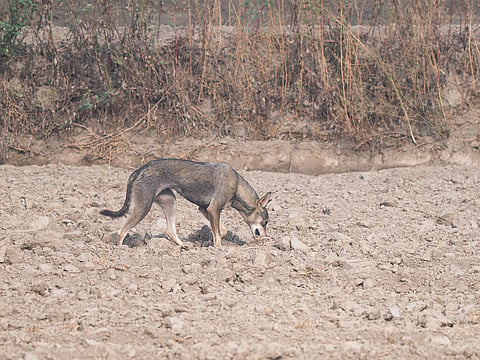

An Indian grey wolf (Canis lupus pallipes) has been sighted within the borders of Delhi for the first time after the 1940s, according to a report by the Hindustan Times.
The animal was photographed by wildlife enthusiast Hemant Garg on May 15, 2025, in Palla, a village on the banks of the Yamuna at a place where the borders of Delhi, Haryana and Uttar Pradesh meet.
“There is a bund road over there which I have been regularly traversing for the past couple of years. We usually sit down, relax and also click birds and animals,” Garg told Down To Earth (DTE).
He has photographed nocturnal wildlife like in and around Delhi and the Yamuna’s floodplain. “I have shot photos of leopards, hyenas, rusty spotted cats, civets, porcupines, snakes and pythons. So, I am able to make out if there is something unusual,” Garg added.
When he saw the animal, Garg said he knew it was not a dog. I asked a person who farms a leased plot of land nearby as to what it was. He said it was a jackal.
“But I knew it was not a jackal either. It was too big for one. The muzzle of a jackal is triangular and thinner. This animal’s muzzle was profound and strong,” Garg told DTE.
He added that the animal’s gait was stealthy. “It did not come across as a dog because as soon as I pulled out my camera and tried to take a few photos, it just saw me and hid itself in the tall patch of grass behind. There, it sat down in an ambush sort of position before disappearing in the grass.”
The shoulders were more prominent, and the coat was greyish in various places, especially the shoulders and head. For Garg, the animal looked like a dog but did not behave like one. It behaved like a jackal but did not look like one. “So, I was very perplexed.”
He spoke to his friend Abhishek Gulshan, a naturalist based out of Delhi who runs a community called Ninox. “At first, we laughed it off,” said Garg.
But then, he remembered something else. The Yamuna is currently almost dry and there are patches where there is just ankle-deep water. The patches are as thin as 10 metres across.
Garg said the opposite bank from Palla is Baghpat district of Uttar Pradesh, which is a mix of grassland and woods. “We have had reports of leopards crossing the river and entering these areas before. We did know this area had movement of wild animals. But this was the first kind of a record for a wolf anywhere in and around Delhi.”
His friend Gulshan sent the photos to Surya Ramachandran, a wolf expert based in Chennai. Gulshan shared it with another Pune-based naturalist. “They did not even ask for any profile though I had taken a side profile photograph. They were positive that it was an Indian grey wolf.”
Garg said he did not rule out the animal being a wolfdog hybrid. “Ramachandran, however said the wolves in Pune and Uttar Pradesh’s Bahraich looked very similar. Hybridisation cannot be ruled out, but it still would be closer to a wolf than a dog.”
When DTE spoke to Wildlife Institute of India scientist Bilal Habib, he replied in the affirmative of the animal being a wolf and not a wolfdog.
“It is a very young animal, a year-old subadult that is dispersing. Its coat is a giveaway, typical of subadult wolves. Its teeth are also small and very sharp,” said Habib.
“Hybridisation is an issue. But a wolfdog hybrid will hang out nearer to human settlements, not disperse over such long distances. I have similar photos of young individuals who are a year old,” he added.